How to unscrew a valve on a gas cylinder: safe ways to disconnect a valve
From the old cylinder, you can build various useful devices, from the grill to the home-made stove. But first you need to disassemble it, and for this you need skill. The first step is to deal with the valve.
You do not know how to unscrew a gas cylinder, but are you determined to do it yourself? We will help you deal with this issue. Our article discusses the main stages of twisting the valve and provides useful recommendations that will help to cope with the solution to this problem. Also selected step-by-step photos and thematic videos.
The content of the article:
Types and device of the valve
Before you go into practice, you have to get a little acquainted with the theory and figure out which way the valve on the household gas cylinder should be unscrewed. And also briefly consider the device of the cylinder and the valve itself. This knowledge will help you cope with the task.
So, the main structural elements can be considered in detail in the following image.
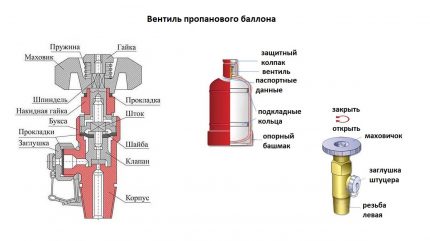
Gas cylinder valve - This is a stop valve, which is used for storage, use, filling and safe transportation of vessels (cylinders) operating under pressure. The features of their use are regulated Resolution No. 91 on safe operation of June 11, 2003, which states that each product must comply with GOST, be marked with a designation of operating pressure and temperature.
Most often on propane-butane cylinders one can find valves of the VB-2 and VB-1 brands. The body of such a crane is extremely simple and equipped with a handwheel that rotates easily by hand.Such valves are installed on gas cylinders at a pressure of up to 1.6 MPa. It is possible to join balloon gear and a pressure regulator, for which purpose there is a union nut with a left-hand thread in the crane design.
Connecting sizes of the VB-2 brand valve:
- at the outlet for gas sampling, SP 21.8 - 14 threads per 1 ″ left;
- for installation on a cylinder - tapered thread with a diameter of W19.2, W27.8, W30.3.
The lateral fitting of the cylinder valve used to store combustible gases is always made with left-hand thread. But for non-combustible - on the right. This measure is designed to protect the average user, who decided to independently connect the cylinder to gas-powered equipment.
In this way, accidental explosive mixing of, for example, propane-butane or hydrogen with oxygen is prevented.
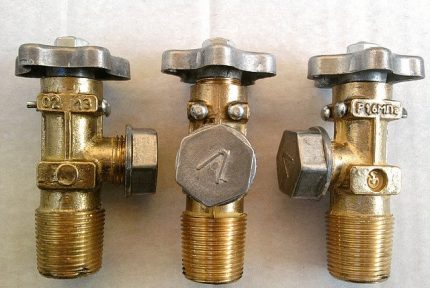
Detailed instructions for loosening the crane
Looking for information on how to quickly and safely turn off a propane-butane gas cylinder tap? Then read our instructions and see the step by step photos posted just below.
In order to cope without any difficulties with a valve that can “tightly sit” in the neck of a cylinder, it will take some force. And, depending on the devices at hand, an assistant may be needed.
If you have one single cylinder, and for the first time you are going to twist the valve, you will have to tinker while getting used to it. If you are gathered disassemble the cylinder and put the manufacture of various home-made bottles from cylinders on the stream, then you simply can’t do without good tools at hand.
First you need to release the remaining gas, if any, in this cylinder. Why just turn the valve handwheel in the direction indicated on it. If there is still gas inside, then you will hear a characteristic hiss - these are the remnants of the liquefied gas.

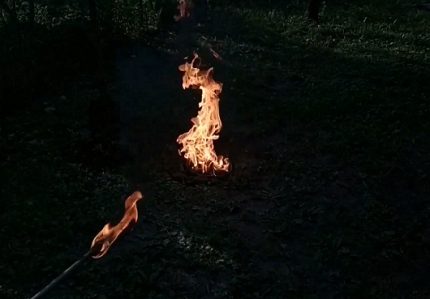
Then you need to fix the cylinder body. How to do this - completely depends on your imagination and the devices at hand. For these purposes, they use welding, metal pins, a vice, a board, clamp the balloon with the wheel of a large car, fasten it with a belt to a tree, and many more options. Therefore, choose for yourself that method of fixation that will be convenient for you.
The main task is to immobilize the cylinder. We will consider the process of unwinding the valve in the simplest example - using a vise. Step-by-step instructions can be found in the following photo selection.
In most cases, there are no problems with opening the valve - such a simple method allows you to safely unscrew it.
Overview of the best ways to unscrew the valve
But the considered method is not the only one. Many home craftsmen offer a number of other options, using various improvised tools. We offer 7 simple ways to unscrew the valve using improvised tools. If you do not succeed the first time, then you can always apply another option.
Method # 1 - clamp the shoe in a vise
In a vice it is necessary to clamp the body of the cylinder. Why shoe securely fixed with a vise.
You will also need an adjustable wrench and a pipe to extend the handle.
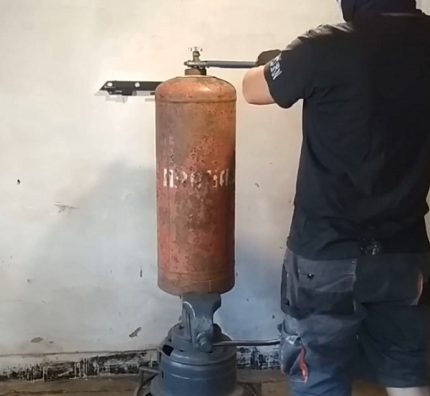
Having put on the mittens, it remains to grasp the elongated handle of the key and, with an effort, twist counterclockwise. At first, everything will go tight, but having made half a turn, the valve will go much easier. In the end, you can unscrew it with your hands.
Method # 2 - clamp the crane in a vise
The second method is no less simple than the previous one. All that is needed is to hold the cylinder valve in a vice, and twist it by the body, using straps for this.

The first revolution will be difficult, and then you can complete the twisting by hand, laying aside a metal pipe.
Method # 3 - vise + metal corner
This option provides the same type of cylinder mounting in a vise as the previous one - with a crane in a vise. But instead of belts and chains, a metal corner is required. It is welded to the shoe in two places.
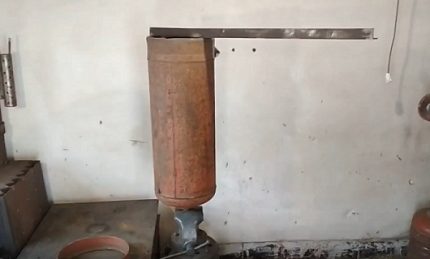
This method with welding is simple if you have a welding machine in the garage and you know how to use welding. With regard to safety, there is no need to be afraid to weld a metal structure to the shoe - you will not damage the container in any way.
Method # 4 - using two keys
To implement this method of unscrewing the valve, you will need two keys - No. 5 and No. 3.
The large key (No. 5) will have to tighten the thread onto which the transport cap is usually wound to protect the valve.
A key number 3 will be used to unscrew the crane. It is advisable to extend its handle using a suitable length of pipe.
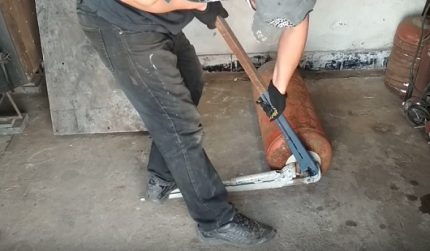
Method # 5 - welding the shoe
If there is a welding machine and the ability to handle it, we will conveniently use the method of welding the base of the cylinder (shoe) to any surface. For example, to the metal legs of a table or to a workbench. Moreover, it is enough to fix the stand by welding in two places.
Then you can use the same key No. 3 with a lever (a long metal pipe that is worn on the handles of this key).
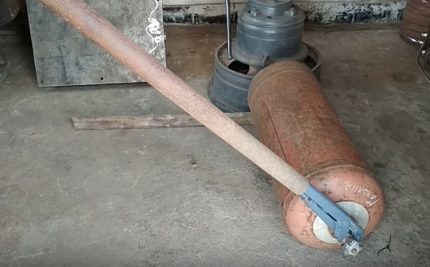
Method # 6 - belts + key
Belts or chains to pull the body of the cylinder to something firmly fixed - a corner, a tree trunk. Then take the key number 3 and turn off the tap, remembering that it has a tapered right thread - i.e. twist counterclockwise.
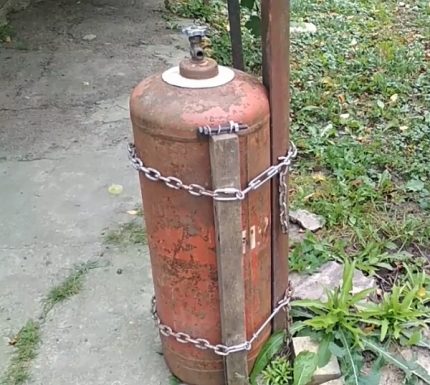
Method # 7 - fixing the cylinder in the pit
Another reliable fixation method is in the pit. First you need to screw a metal tube up to 1 m long to the shoe. For this, you can use the already existing holes in the shoe. If they are not there, then drill.
Then dig a hole about half the height of the vessel, place the prepared balloon inside with the screwed tube, cover it with earth and tamp lightly.
It remains only to take the key and untwist the valve counterclockwise.
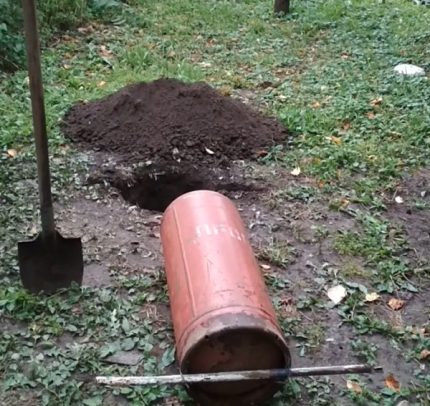
In winter, instead of a hole, you can use the ice hole by freezing a balloon in it.
Having figured out how you can unwind a gas cylinder at home, you can safely use any of the methods you like. But at the same time, it is important not to forget about safety - working with a cylinder can result in very dire consequences. Read about it later.
Safety Rules for Using the Valve
If you have never been involved in twisting a crane, then it will not be superfluous to familiarize yourself with the safety rules before starting such work.
Valve operation is regulated by documents such as PB 12-368-00 “Safety rules in the gas industry”, Decree No. 91 of June 11, 2003 “Rules for the design and safe operation of pressure vessels” and GOST 12.2.008-75.
Disassembly, repair and replacement of the valve should only be carried out by persons authorized to repair gas equipment. A repair of a device under pressure is strictly prohibited. Therefore, if you notice that the valve is poisonous or defective, then the right decision would be to contact a gas service representative, and not to repair at your own risk.
If you want to disassemble an old cylinder, to make a useful homemade product of it like potbelly stovessmokehouse or gas grill, it is worth remembering that these actions can not be called safe. And you will have to answer for the consequences.
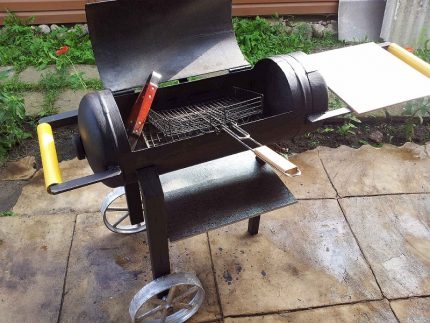
All actions to unwind the cylinder should be carried out on the street or in a well-ventilated garage, another room. But in the apartment it is absolutely impossible to do this - such an experience may end the explosion.
Next, we consider the basic safety rules that are important to observe:
- To drain off the gas residues, the crane flywheel should be loosened slowly and slowly.
- Under no circumstances should the cylinder under pressure be dismantled or sawed.
- There should be no other cylinders near the disassembled vessel.
If you are just about to unscrew the valve and haven’t done anything yet, and in the garage where the cylinder was standing, you can clearly smell the gas, you should ensure maximum ventilation of this room. Why open the gates, windows, doors (if any), and leave immediately.
Conclusions and useful video on the topic
If you have never been involved in unscrewing a valve from the neck of a cylinder, we recommend that you watch the following video:
Unscrewing the valve using a vice, a metal pipe and a clamp:
Having familiarized yourself with simple ways to unscrew the gas cylinder tap, you can choose the most suitable one for yourself. But it is important to remember the safety rules - unfortunately, there are cases when gas cylinders explode during careless handling of ordinary people. Therefore, after weighing the pros and cons, it is better to contact the gas station, where for a nominal fee they will unscrew the valve from the old cylinder or replace it.
Do you have your own opinion about the promotion of a gas cylinder in artisanal conditions using improvised means and you want to share it with other users? Or want to tell about your experience of unscrewing a valve? Write your comments, add original photos, participate in the discussion - the feedback form is located below.

 The device of the valve on a gas cylinder and methods for replacing it if necessary
The device of the valve on a gas cylinder and methods for replacing it if necessary  How to flush a gas bottle: safe ways to flush the receiver
How to flush a gas bottle: safe ways to flush the receiver  Why is a gas cylinder covered with hoarfrost: causes of freezing of gas in the cylinder and ways to prevent it
Why is a gas cylinder covered with hoarfrost: causes of freezing of gas in the cylinder and ways to prevent it 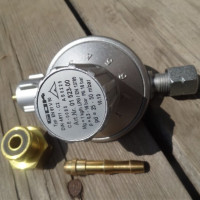 Why the gas cylinder gearbox buzzes: what to do if the gas pressure regulator is noisy
Why the gas cylinder gearbox buzzes: what to do if the gas pressure regulator is noisy 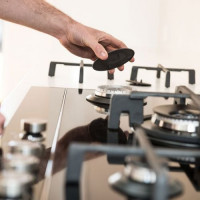 Why the burner does not work on the gas stove: common causes and methods for eliminating them
Why the burner does not work on the gas stove: common causes and methods for eliminating them 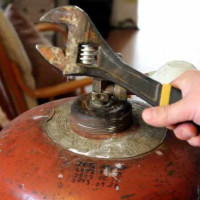 How to disassemble a gas cylinder: step by step instructions + precautions
How to disassemble a gas cylinder: step by step instructions + precautions  How much does it cost to connect gas to a private house: the price of organizing gas supply
How much does it cost to connect gas to a private house: the price of organizing gas supply  The best washing machines with dryer: model rating and customer tips
The best washing machines with dryer: model rating and customer tips  What is the color temperature of light and the nuances of choosing the temperature of the lamps to suit your needs
What is the color temperature of light and the nuances of choosing the temperature of the lamps to suit your needs  Replacement of a geyser in an apartment: replacement paperwork + basic norms and requirements
Replacement of a geyser in an apartment: replacement paperwork + basic norms and requirements